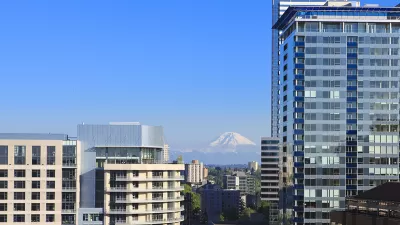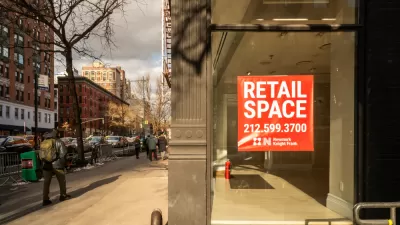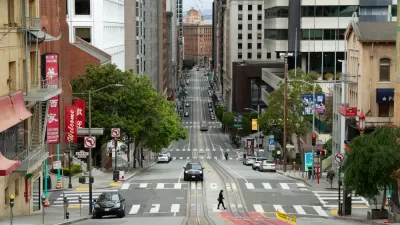The Bay Area Council and CBRE created an economic tracker to measure how well the nation's 25 largest metropolitan areas have recovered from the public health restrictions imposed on their regions at the onset of the pandemic.

“San Francisco’s recovery from the throes of the COVID-19 pandemic is one of the worst in the country among major metropolitan areas, according to an economic recovery tracker launched Tuesday by the Bay Area Council business group,” reports Eli Walsh of the Bay City News Foundation on Feb. 28.
That would be the San Francisco metropolitan statistical area, not the city. From a related, pandemic post:
Metros, or Metropolitan Statistical Areas (MSAs), are census-defined regions that consist of a city with 50,000 or more inhabitants and its surrounding communities.
The San Francisco–Oakland–Berkeley metro consists of five counties: Marin, San Francisco, San Mateo, Alameda and Contra Costa.
“Among the 25 largest metro areas in the country by regional gross domestic product, San Francisco’s pandemic recovery ranked 24th on the Regional Economic Recovery Index, besting only Baltimore,” adds Walsh.
San Jose fared better, but is still in the back half of the ranking at 16th. The Austin, Dallas and Denver metro areas have had the greatest recovery to date, according to the Bay Area Council.
The initial report by the council's Economic Institute, prepared in partnership with the commercial real estate services company CBRE and its Tech Insights Center, is the first of a three-year, three-part series of interactive reports focused on the Bay Area's economic recovery.
"The index portion of the project is focused on the 5 county San Francisco MSA (plus 2 county San Jose MSA)," wrote Abby Raisz of the Bay Area Council in an email on March 2. “The 'Bay Area Deep Dive' section includes charts that encompass the entire 9 county Bay Area.”
The region was the first in the nation to issue a "shelter in place order” on March 16, 2020, and appears almost last to recover from shutting down all but essential services in order to stem the transmission of the coronavirus that causes COVID-19.
“As the region recovers, it is clear that the pandemic has permanently changed how and where people work, how businesses think about their location decisions, and where households choose to live," notes the project summary of the report. “These effects appear to be most visible in expensive coastal regions, including the San Francisco Bay Area.”
Austin, Texas ranked first across the 25 regions in the study, scoring an average of 86 (out of 100) across the 15 metrics evaluated, according to the report's index methodology:
Within these metrics, it ranked first (100/100) on 6 metrics: job growth, “knowledge worker” growth, population growth, labor force growth, net absorption, and new housing units per capita. It also scored high (second only to Denver) on change in sales tax revenue – experiencing an increase of $33 million (or 13%) from 2019 to 2021.
These figures speak to the dramatic resilience and growth Austin, and Texas as a whole, experienced during the pandemic, while coastal cities like San Francisco and New York continue to suffer losses.
Related post detailing the population loss in the Bay Area: State Estimates Show Third Year of Population Loss for California, February 5, 2023,
Hat tip to my local paper, the San Mateo Daily Journal.
FULL STORY: SF pandemic recovery one of the worst in U.S. among largest metro areas

Trump Administration Could Effectively End Housing Voucher Program
Federal officials are eyeing major cuts to the Section 8 program that helps millions of low-income households pay rent.

Planetizen Federal Action Tracker
A weekly monitor of how Trump’s orders and actions are impacting planners and planning in America.

Ken Jennings Launches Transit Web Series
The Jeopardy champ wants you to ride public transit.

Crime Continues to Drop on Philly, San Francisco Transit Systems
SEPTA and BART both saw significant declines in violent crime in the first quarter of 2025.

How South LA Green Spaces Power Community Health and Hope
Green spaces like South L.A. Wetlands Park are helping South Los Angeles residents promote healthy lifestyles, build community, and advocate for improvements that reflect local needs in historically underserved neighborhoods.

Sacramento Plans ‘Quick-Build’ Road Safety Projects
The city wants to accelerate small-scale safety improvements that use low-cost equipment to make an impact at dangerous intersections.
Urban Design for Planners 1: Software Tools
This six-course series explores essential urban design concepts using open source software and equips planners with the tools they need to participate fully in the urban design process.
Planning for Universal Design
Learn the tools for implementing Universal Design in planning regulations.
Heyer Gruel & Associates PA
Ada County Highway District
Institute for Housing and Urban Development Studies (IHS)
City of Grandview
Harvard GSD Executive Education
Toledo-Lucas County Plan Commissions
Salt Lake City
NYU Wagner Graduate School of Public Service





























